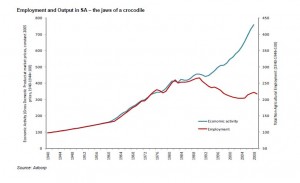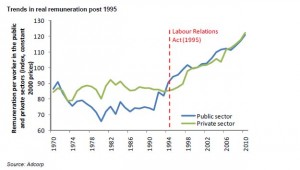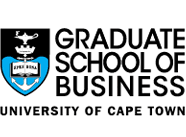While headline annual consumer inflation was unchanged at 3.7% in February, the underlying trend indicates a somewhat faster rate of inflation of about 4.2%. These trends may be calculated as the monthly move in the seasonally adjusted and smoothed CPI, which is then annualised, or as the quarter to quarter annualised increases in the CPI. Both are running at a similar rate of above 4%. If the current trends are sustained the inflation rate will approach 5% over the next 12 months.
To view the graphs and tables referred to in the article, see Daily Ideas in todays Daily View:
Daily View 24 March – Inflation and Interest Rates
The forces pushing up prices are in part global in the form of rising dollar prices for food and energy. These, as the Reserve Bank pointed out in its Quarterly Bulletin, have been rising sharply as a result of increased demands and some supply side disruptions or expected disruptions in the supply of oil from the Middle East.
Breaking down the February data
The counter to such pressures has been the strength of the rand over the past 12 months. This counter pressure has been more effective in the case of food and less so for the petrol price. The food price component of the CPI is up by 3.6% compared to a year ago. Food prices actually fell by 0.1% in February 2011. The petrol price rose by 3.1% in February and higher oil prices, as well as higher excise taxes on petrol, took the year on year increase in petrol prices to 12.1%.
Food and non-alcoholic beverages account for 15.68% of the CPI basket while transport costs have a large weight of 18.8%. However Purchase of Vehicles carries by far the largest component of transport costs with a weight in the basket of 11.8% out of the 18.8% allocated to transport generally. Petrol has a weight of 3.93% and Public transport also influenced by the petrol and diesel prices has a 2.73% share of the CPI.
Owing to the downward pressure the strong rand placed on new vehicle prices, the overall transport component only increased by 2.6% over the past 12 months despite the higher petrol price. Including the prices of new vehicles rather than their implicit or explicit leasing or rental rates is surely an anomaly in the calculation of the CPI. It is the opportunity implicit or explicit leasing costs of owning a vehicle rather than the price of a vehicle that matters to households. The price of a new or used car furthermore is hardly something clearly indicated on any price list. It will be affected by financial arrangements and by warranties as well as residual and trade in values, all designed to help make a sale.
This anomaly (rentals or prices) is avoided in the case of another important category that makes up the CPI. That is the item Owners’ Equivalent Rent that makes up 12.21% of the basket with Actual rentals for housing making up a further 3.49% of the basket. Electricity prices, which rose by 18.6% over the past 12 months, have a weight of but 1.87%. Actual rents are estimated to have increased by 5.4% and owners’ equivalent rents by 3.9% over the past 12 months. Rentals were unchanged in February, presumably because they were not surveyed last month.
The future of rentals and the rate of inflation will be determined by the state of the housing market. Short term interest rates and the availability of mortgage bonds will clearly influence house prices, rents and rental returns and these will take their cue from the rand. However if house prices rise rapidly landlords may well accept a lower rental rate of return and vice versa. When house prices fall rental may prove much stickier leaving the direction of rentals somewhat independent of house price inflation.
Nevertheless home owners are likely to spend more rather than less as their balance sheets improve with higher house prices, which is unlike the case when most other prices rise. Higher (relative) prices generally restrain rather than encourage extra demands.
The right medicine
This brings attention to the most important contributor to the monthly increase of 0.7% in the CPI. Increased costs of insurance, especially medical insurance, rose by 5.2% in the month and contributed 0.4 percentage points of the increase in prices. These insurance costs are also only surveyed annually rather than monthly and revealed a year on year increase of 4.2%. Are not such increases reflective of the increasing real shortages of skilled medical personnel rather than demand side pressures on prices?
Such shortages of skills are exacerbated by the difficulties imposed by our immigration policies. They show up also in the rate of inflation of educational services provided to households. Primary and secondary education became 10.2% more expensive over the past twelve months and tertiary education was up by 7.9% over the same period.
The forces that restrain domestic inflation and the pricing power of local suppliers are the prices paid for imported goods and services and also the employment benefits received by the internationally mobile owners of scarce skills. Thus the value of the rand is the key to the underlying rate of inflation in SA.
Efforts taken to weaken the rand mean more rather than less inflation. They would also mean slower rather than faster growth, particularly in household spending, which responds favourably to lower prices and lower interest rates that follow lower prices. Growth and inflation in SA over the next twelve months will depend mostly on the global forces that determine resource and commodity prices and capital flows to emerging markets, including SA.
The most favourable outcomes for the SA economy – faster growth with low rates of inflation – will be those associated with rising commodity prices and so a strong rand. High prices for metals and minerals and inevitably also the price of oil (and also coal that we export so much of) represents good news for the SA economy. These forces proved most helpful in reviving the economy in 2010. We must hope for further fair winds to blow in from the global economy in 2011 and restraint from the SA Reserve Bank.


